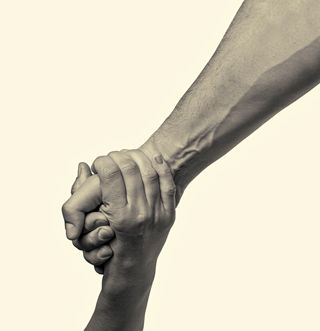Trust
How to Avoid Getting Conned
Seven ways to bolster your anti-con defenses.
Posted September 12, 2019
This article is co-written with Andres Munoz a social psychology graduate student working with Dr. Athena Aktipis in the Cooperation and Conflict Lab at Arizona State University and Dr. Lee Cronk, Professor of Anthropology at Rutgers University, both members of the Human Generosity Project. Munoz is conducting research on psychological mechanisms that protect from exploitative behaviors.
Trust allows us to coordinate with others to overcome insurmountable obstacles and to obtain otherwise inaccessible benefits. Imagine that you live during the time of our hunter-gatherer ancestors. One day you go on a hunt and encounter a Woolly Mammoth. Killing the mammoth would confer a wealth of resources. However, fighting a 6-ton beast with 10-foot tusks by yourself might not turn out well. Rather than being trampled to death, you recruit some buddies to take on the massive beast. Trusting is a double-edged sword: essential in our recruitment of others for help, yet it makes us vulnerable to exploitation. After defeating the mammoth, one of the hunters might decide to keep all the resources to themselves. To prevent this, you would need psychological strategies to identify exploitation attempts. Cons are the modern version of this ancient tension between people who try to exploit others and cooperators who need to identify and protect themselves from being taken advantage of.

Cons are situations in which a perpetrator builds trust, through deceit, in the pursuit of some benefit for the con artist and at a cost to the victim. The Cooperation and Conflict Lab at ASU, in collaboration with The Human Generosity Project investigates our ability to detect cons and the situations under which our con-detection systems are most likely to fail. In some situations, we remain vulnerable to cons despite evolved defense mechanisms. Does this vulnerability mean that we should stop trusting people? By understanding the science behind conning, we can better protect ourselves from con artists while still allowing us to reap the benefits of trust. Following are seven ways to bolster your defenses against cons.
1. Accept your vulnerability.
It’s tempting for an observer to think that the victim of a con must be incredibly gullible and that a similar tragedy would never befall them because they’re too smart. However, no matter how smart, our evolved psychological mechanisms that promote trust leave us open to being conned. Coming to terms with our vulnerability can reduce the tendency to blame the victims of cons for their misfortune. Often, the shame associated with being conned can discourage victims from sharing their stories. It’s essential to recognize that anyone could fall prey to a con so that we can create an understanding environment for victims to share valuable information that could prevent others from being taken advantage of.
2. Be skeptical of get-rich-quick schemes.
One type of con exploits our motivation to acquire resources. This motivation to acquire helped our ancestors survive and reproduce by assisting them in gaining vital resources such as food and water. Cons that exploit our motivation to acquire resources typically involve convincing victims to invest in a bogus “get rich quick” opportunity. Often, victims of this type of con are in dire financial situations and need money quickly. Thus, con artists exploit either greed or need in this type of con. Financial miracles are rare, so it’s useful to maintain a healthy skepticism when approached with plans involving large gains coupled with inconsistently low risk. As they say, “If it seems too good to be true, it usually is.” This saying also applies to situations where salespeople try to con potential clients into buying a product or service that they know is not in their potential clients' best interest. Although many salespeople believe in the products and services they are attempting to sell, some are willing to use deception in pursuit of commissions and metrics. Therefore, it's best to research a product or service before making a purchase from a salesperson.
3. Recognize that your generous nature could be exploited.
One common type of con exploits our motivation to help people in need. Research suggests that helping each other in times of need not only feels morally right, but can also have great immediate and long-term benefits for the helper. Some of the benefits of helping include a boost in reputation (Molleman, van den Broek, & Egas, 2013), elevated mood (Yinon & Landau, 1987), better relationship satisfaction (Brunstein, Dangelmayer, & Schultheiss, 1996), and even improvements in mental and physical health (Brown, Nesse, Vinokur, & Smith, 2003; Schwartz, Meisenhelder, Ma, & Reed, 2003). Research by the Human Generosity Project suggests that helping others can improve resilience in the face of uncertainty (Aktipis, Cronk, & De Aguilar, 2016; Aktipis, Cronk, De Aguilar, 2011; Hao, Armbruster, Cronk, Aktipis, 2014).

As described in a blogpost by Lee Cronk and Athena Aktipis, Maasai cattle farmers in East Africa have relationships known as “Osotua,” which translates as “umbilical cord.” Osotua partners help each other in times of need without specific expectation of repayment. While these relationships allow the Maasai to survive when they experience unexpected losses due to events such as droughts, they are not unique to the Maasai. The Human Generosity Project has identified a range of similar relationships across the globe (Cronk et al., 2019).
Even in our modern environments, it pays to have people that you can rely on during times of need. For example, you might know somebody whose house burned down during a fire in California, somebody who unexpectedly lost their job, or somebody who fell ill and needed an expensive medical procedure. In all of these terrible situations, many people turn to their friends and family for help.
Given the benefits of helping each other in times of need, it’s not surprising that we are often motivated to help others. However, by helping others, we potentially become vulnerable to greedy people who feign need. Cons in this category usually involve presenting the victim of the con with a fake emergency and asking this target for help. For example, have you ever been at a gas station and had a stranger approach you to ask you for gas money? Or claim that their car is stranded somewhere else and that they need money to pay a tow truck? You might feel inclined to help the people in these situations, but sometimes these monetary requests are deceits. This type of con exploits our cooperative nature and is particularly destructive; they can lead us to become suspicious of people in need and reduce our likelihood of assisting even in situations when the need may be real.
4. Supplement your intuition with the latest information.
To decrease our vulnerability in the face of con artists, how can we better defend ourselves without becoming an isolationist or cynic? Ongoing research from the Cooperation and Conflict Lab at Arizona State University, as part of the Human Generosity Project, suggests that we can each tune into situations where we might be exploited and detect cheating on norms like “don’t ask for help unless you are truly in need.” We have natural alarm systems that aid us in detecting greediness and other types of social norm violations. Perhaps this can give us some hope. However, as with any other human system, our con-alarm is not perfect. We often face information and time constraints that make it particularly difficult to determine whether someone is truly in need or whether a resource acquisition opportunity would be worthwhile. In addition, our biases and decision-making are also based on our history and preconceived beliefs.
While trusting our natural con-alarm often pays off, it is useful to supplement our natural intuitions with knowledge about how cons occur in our modern environments. Just as computer programs can be made more efficient and better adapted to changes in technology through software updates, our evolved con-alarm systems can benefit from inputs of information as we continue to learn more about cons. Upgrading our natural con-alarms by learning about cons should help us discern between the conditions under which our natural defense mechanisms are likely to be vulnerable and when they are less likely to be vulnerable so that we can selectively activate our skepticism depending on the situation. If we identify that we are vulnerable in a particular situation, research into cons can provide us with strategies for testing whether a situation is likely to be a con or not so that we can continue to be trusting and generous if we determine that there is no need for concern. Thus, the fact that cons exist should not preclude us from having basic faith and trust in the good nature of the average stranger. Learning about cons should facilitate our ability to trust in our modern environments while guarding ourselves under the right circumstances. Here is a webpage by the United States government that can serve as a source of information to supplement your natural intuition; it describes some of the most common types of cons and how to report and protect yourself from each.
5. Be vigilant with online requests.
It is useful to consider how our current environments might be different from those of our hunter-gatherer ancestors to understand how our psychological defenses might be out of date. Mechanisms that protected us from exploitation are likely to have evolved from an environment that was substantively different from modern environments. Imagine living among our hunter-gatherer ancestors. A stranger says that he doesn’t have enough meat to feed his family and asks you for some meat. You just returned from a successful hunt, so you have some meat to spare and you give the man some meat. What would it take for this man to disappear from your life forever after receiving that meat? He would probably need to abandon his small band of hunter-gatherers, which would pose great risks. In fact, you could ask around the camp and acquire information about the man, which would allow you to retaliate if you find out that you have been conned. In the hunter-gatherer world, there was less risk in trusting and giving resources to someone who appeared to be in need.
The modern world: you get a desperate message from a friend or acquaintance through social media asking for money for an emergency and you decide to help. You later find out that the person asking you for money was not who they said they were. What would it take for this person to disappear from your life forever after receiving the money? They already have - there may be no way to track or follow up with this person. Cities with millions of inhabitants, along with modern methods of transportation and long-distance communication, have made it easier than ever for a con artist to vanish into the crowd or move to a different city after exploiting someone. In addition, wealth is often much easier to hide in modern environments than it was for our hunter-gatherer ancestors, which makes it more difficult than ever to know whether someone is truly in need.
Many opportunities for conning have emerged with the invention of modern modes of communication such as the internet. Modern forms of communication often reduce the risk incurred by a con artist because they negate the physical distance between victim and perpetrator and make it relatively easy to remain anonymous. Moreover, our ancient psychological defenses might not be adequate for the detection challenges of the modern world, particularly when modern forms of communication are involved. Our natural con-alarm is likely to rely, at least in part, on visual and auditory cues such as facial expressions and vocal pitch because these were the cues that were available to us as hunter-gatherers. Thus, our natural con-alarm is particularly susceptible to cons that involve written communication, such as email or text messaging, that lack important visual and auditory inputs; an extra dose of skepticism is beneficial for these modes of communication.
6. Ask for more information.
Cons are based on deceit. If you ask for enough information, cons often fall apart. Imagine that a woman asks for money for her son who has fallen ill. What could you do to find out if it’s a con? A few questions might do the trick. For example, you could ask for the name of the doctor that is treating her son. The con artist can’t memorize every possible detail beforehand, so she might be forced to make up a name. Later in the conversation, you casually ask what the name of the doctor was again. The con artist might be unable to recall the name that she gave you earlier and give you a different name or realize that you’re onto her and give up the con. The more details the con artist is forced to produce, the more likely it is that the lies will be inconsistent, and the fraudulent nature of the request will be revealed.
When a con artist is asked to provide more information, they are often forced to tell more lies. Thus, it’s useful to know what cues suggest that someone might be lying. Here are some potential cues suggested by Pamela Myer, author and certified fraud examiner:
1) changes in vocal pitch
2) difficulty making eye contact
3) unusual blinking or fidgeting
4) use of self-soothing maneuvers like ear tugging, neck touching, collar pulling, or mouth covering
5) inconsistent gestures or facial expressions that contrast with the message.
For more information on this topic, check out this TED talk by Pamela Myer on how to detect a liar.
7) Help without giving money.
Con artists want your resources. If a con artist tries to get money by asking for help, remember that money is often not the only way to lend a hand. If you offer help that doesn’t involve giving money or material goods, the con artist is likely to turn it down or even get frustrated and insist on needing money. For example, imagine that a woman asks you for money for her sick child. If you’re a lawyer, offer legal advice. If you play the guitar, offer to visit her son and play a song to make him feel better. There are countless ways to help without writing a check when your con-alarm has been activated; no need to give up your generous nature when you suspect a con is taking place.
Thanks for following. Comments always appreciated.
References
Aktipis, C. A., Cronk, L., De Aguilar, R. (2011). Risk-pooling and herd survival: An agent-based model of a Maasai gift-giving system. Human Ecology, 38.
Aktipis, A., de Aguiar, R., Flaherty, A., Iyer, P., Sonkoi, D., & Cronk, L. (2016). Cooperation in an Uncertain World: For the Maasai of East Africa, Need-Based Transfers Outperform Account-Keeping in Volatile Environments. Human Ecology, 44, 353–364. https://doi.org/10.1007/s10745-016-9823-z
Brown, S. L., Nesse, R. M., Vinokur, A. D., & Smith, D. M. (2003). Providing Social Support May Be More Beneficial Than Receiving It: Results From a Prospective Study of Mortality. Psychological Science, 14(4), 320–327. https://doi.org/10.1111/1467-9280.14461
Brunstein, J., Dangelmayer, G., & Schultheiss, O. (1996). Personal Goals and Social Support in Close Relationships: Effects on Relationship Mood and Marital Satisfaction. Journal of Personality and Social Psychology, 71(5), 1006-1019.
Cronk, Lee, Colette Berbesque, Thomas Conte, Matthew Gervais, Padmini Iyer, Brighid McCarthy, Dennis Sonkoi, Cathryn Townsend, and Athena Aktipis (2019). Managing risk through cooperation: Need-based transfers and risk pooling among the societies of the Human Generosity Project. In Global Perspectives on Long-Term Community Resource Management, Ludomir R. Lozny and Thomas H. McGovern, eds. Springer.
Hao, Y., Armbruster, B., Cronk, L., Aktipis, A. (2014). Need-Based Transfers on a Network: A Model of Risk-Pooling in Ecologically Volatile Environments. Evolution and Human Behavior, 265-273.
Molleman, L., van den Broek, E., & Egas, M. (2013). Personal experience and reputation interact in human decisions to help reciprocally. Proceedings of the Royal Society B: Biological Sciences, 280(1757). https://doi.org/10.1098/rspb.2012.3044
Schwartz, C., Meisenhelder, J., Ma, Y., & Reed, G. (2003). Altruistic Social Interest Behaviors Are Associated With Better Mental Health. Psychosomatic Medicine, 65(5), 778–785. https://doi.org/10.1097/01.PSY.0000079378.39062.D4
Yinon, Y., & Landau, M. O. (1987). On the reinforcing value of helping behavior in a positive mood. Motivation and Emotion, 11(1), 83–93. https://doi.org/10.1007/BF00992215




